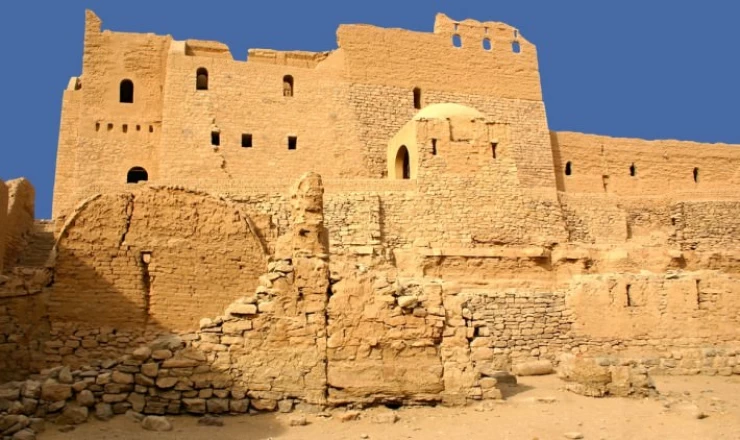
Saint Catherine Monastery
Saint Catherine Monastery
Historic and Religious Significance: Geographical Location: The monastery stands in the Sinai Peninsula, an isolated and harsh region, which is deemed to be the very place where Moses, according to tradition, witnessed the burning bush. It is one of the most potent sites in Christianity, with recognition by the Eastern Orthodox Church as a powerful shrine.
Saint Catherine: The monastery is said to be dedicated to Saint Catherine: according to tradition, relics of hers were discovered here in the 9th century, though there remain diversities in the accuracy of that event in the figments of history.
Place of Pilgrimage: The monastery itself has witnessed a fair share of pilgrimage for Christians over the years, especially of Eastern Orthodoxy. Such pilgrimage visitors have included important religious and scholarly figures. It was built in the year 527 A.D. by the emperor, the Emperor, on the remains of a chapel erected by the Emperor's capital of Montana in 337 A.D., at the purpose wherever tradition has it that Moses saw the burning bush and God speak to him there.
St. Catherine suffered martyrdom in Alexandria within the fourth century. per the story, she was tortured on the wheel, beheaded, and brought away by angels. The religious residence took its name within the tenth century once monks claimed to have found her body intact on the mountain of Saint Catherine, the best mountain in Egypt (2642 m).
Surrounded by high mountains of red granite, the religious residence has remained utterly isolated for several years. To get there, pilgrims had to face an extended and troublesome journey; however, these days, an associate in nursing simply passable road passes through it, connected to most cities on the coast. It's visited daily by many folks. Consequently, the tiny village of Saint Catherine is jam-packed with tour buses, particularly in the morning. The encircling mountains square measure of peculiar beauty; it's common to steer up to Mount Sinai to relish the panorama of the place wherever, per tradition, Moses received the Decalogue.
Inside the walled compound, the 6th-century church is ornate with rock columns encircled by monumental marble pillars and walls coated with gilded icons and paintings. At the chap finish of the church. At the highest of the apsis on top of the altar is one of the foremost beautiful treasures of art, the sixth-century mosaic of the Transfiguration, though it should be troublesome to envision it through chandeliers and painting icons. To the left and bottom of the altar, there's the foremost sacred space within the religious residence, the Burning Bush Church, and it's verboten to the general public.
The churches of Coptic Egypt are indispensable places that have to be covered by cruise passengers who dock in the various Egyptian ports. Our Egypt shore excursions can take you to spend quality time in Cairo during excursions. From Sokhna port, or even if you only stop in another port, we can make it from Port Said shore excursions.
Saint Catherine Monastery
The religious residence was visited by pilgrims from everywhere over the globe, several of whom defied troublesome and dangerous journeys to succeed in the remote and remote website. Today, the paved slip road removed the stakes that were related to a visit here, and therefore the religious residence became a well-liked trip from Sharm El Sheikh and Dahab excursions.
Dahab is reached via Sharm El Sheikh International Airport. Dahab is characterized by the presence of many diving centers, with more than 50 centers. Most of the diving places in Dahab are beach diving. Egypt Day Tours in Dahab will be your gate to enjoyment, diving in the beautiful waters of the Red Sea, as well as a wide range of Dahab Day tours to enjoy all relaxing beach activities. Dahab Safari Day Tours.
You can additionally see what's believed to be the descendant of the initial burnt-out bush within the religious residence complex, and as guests cut items from the bush to take them home as blessings, the encircling space is currently enclosed. Close to the burning bush is the genus Musa Well, which could be a natural fountain that's imagined to provide marital status happiness to people who drink from it.
The holiest piece of St. Catherine’s religious residence is the Chapel of the Burning Bush, a little chamber behind the altar of the basilica. It's typically bolted to the general public, and people in the World Health Organization should take away their shoes, even as Moses did once he neared the burning bush per the Holy Qur'an: ''And once he came there, he was known as, “O Moses, indeed, I'm your Lord, therefore take away your sandals. Indeed, you're within the sacred vale of Tuwa, and that I have chosen you, therefore hear what's discovered [to you]''. (11, 12, 13 Surah Taha).
The monastery’s library, the second largest in the world, includes a valuable assortment of light bibles and ancient manuscripts, together with a handwritten copy of the testament, and has reopened to the general public after 3 years of restoration.
Just within the religious residence walls, you will find a present search for mercantilism replicas of icons. Within the wider religious residence grounds, outside the thick walls, square measure the guest home.
The land is rocky there; therefore, monks created the abbey garden by transferring soil from elsewhere. It contains fruit trees together with "olives, apricots, and peaches" and produces a range of vegetables.
When the monks die, they're buried for the first time within the site. When their bodies are square measure rotten, their bones are extracted and transported to the truck's house. Within the burial vault are seen the bones of thousands of deceased monks, with separate piles of legs, hands, feet, ribs, and skulls. Martyrs and archbishops square measure in open coffins. within the door, dressed in.
Isolation of the religious residence worked to save lots of his oldest icons throughout the eighth century once the Byzantine Emperor "Leo III" ordered the destruction of any pictures portraying the Deliverer or one of all the saints. These early icons are natural and void of vogue and rules for ulterior icons.
The most distinctive inventive treasures within the religious residence square measure the mosaic, which is uncommon for "The Transfiguration of Jesus." On top of the altar of the church, you'll see these healthy mosaics from the sixteenth century behind the gilded icons, geological dating back to the seventeenth century.
An uncommon feature of the religious residence complex is the house of prayer. Created within the sixth century as a refuge for pilgrims, it was reborn into a house of prayer in 1106 for the utilization of native Bedouins.
Latest Articles
Admin
Seabourn Sojourn Cruise Stops in Safaga Port
The Seabourn Sojourn, the flagship vessel of Seabourn Cruise Line's ultra-luxury fleet, was built in 2008 at the T. Mariotti shipyard in Genoa, Italy. Measuring 198 metres, it can accommodate up to 450 guests in its 225 spacious all-suite staterooms.
Admin
Norwegian Sky Cruise Stops in Safaga Port
Norwegian Cruise Line operates a cruise ship called the Norwegian Sky. It was constructed in 1999 and can accommodate 2,004 passengers in addition to 878 crew members. The ship has several dining establishments, lounges and bars, a spa and fitness center, swimming pools, and a number of entertainment areas.
Admin
Explora II Cruise Stops in Safaga Port
Explora II, the second vessel in the Explora Journeys fleet, sets sail in 2024 to redefine luxury cruising. With 461 ocean-front suites, 9 culinary experiences, and 4 pools, this haven of sophistication and sustainability promises an unforgettable "Ocean State of Mind" journey to inspiring destinations.
Admin
Mein Schiff 6 Cruise Stops in Safaga Port
The Mein Schiff 6 is the latest cruise ship in the renowned TUI Cruises fleet, offering passengers a luxurious and sophisticated cruise experience. At 315 metres long, this floating resort features a range of dining options, entertainment, and recreational facilities, including a spa, fitness centre, and sports amenities.
Admin
Mein Schiff 4 Cruise Stops in Safaga Port
When the Mein Schiff 4 cruise ship docks in Safaga, Egypt, passengers are granted access to a realm of ancient wonders. Aboard this state-of-the-art vessel, guests can embark on meticulously curated shore excursions that showcase the region's most iconic landmarks, including the Giza Pyramids, the enigmatic Sphinx, and the remarkable tombs and temples of the Valley of the Kings in Luxor.
Admin
MS Europa Cruise Stops in Safaga Port
The Silver Moon, Silversea's latest flagship, is a luxury cruise ship that offers an exceptional travel experience for Venezuelans exploring Egypt. With a capacity of 596 guests and an impressive 40,700 gross tonnes, the Silver Moon maintains the small-ship intimacy and spacious all-suite accommodations that are the hallmarks of the Silversea brand.























